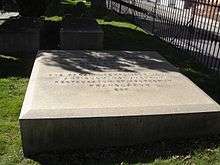Charles-Henri-Louis d'Arsac de Ternay
| Charles-Henri-Louis d'Arsac, chevalier de Ternay | |
|---|---|
 | |
| Born |
27 January 1723 Angers, France |
| Died |
15 December 1780 (aged 57) Duc de Bourgogne, Newport, Rhode Island |
| Buried | Trinity Churchyard, Newport, Rhode Island |
| Allegiance |
|
| Service/branch |
|
| Years of service | 1738-1780 |
| Rank | Rear Admiral |
| Unit | Expédition Particulière |
| Battles/wars |
Seven Years' War American Revolutionary War |
Charles-Henri-Louis d'Arsac, chevalier de Ternay (27 January 1723 - 15 December 1780) was a French naval officer. Most active in the Seven Years' War and the War of American Independence, Ternay was the naval commander of a 1762 expedition that successfully captured St. John's Newfoundland. He was appointed commander of the Marine Royale, French naval forces, as part of the project code named Expédition Particulière that brought French troops to American soil in 1780.[1] He died aboard ship off Newport, Rhode Island.
Early life
Ternay was born on 27 January 1723, probably in Angers, to Charles-François d'Arsac, Marquis de Ternay and Louise Lefebvre de Laubrière. He served as a page in the Knights of Malta beginning in 1737, and joined the French Navy the following year. He rose through the ranks, and received his first command, the Robuste, on 10 January 1761.
Seven Years' War
In 1762, late in the Seven Years' War, Ternay was chosen to lead a secret expedition against the British-controlled island of Newfoundland. With instructions to take and hold the island, and possibly also make an attack on Fortress Louisbourg, then in British hands, Ternay led a squadron of two ships of the line, one frigate, and two flutes through the British blockade of the French coast from Brest on 20 May 1762. Arriving at Bay Bulls on June 20, he landed 750 soldiers, led by Joseph-Louis-Bernard de Cléron d'Haussonville, who captured St. John's without resistance from its small British garrison. Ternay then oversaw the destruction of St. John's fishing stages and fishing fleet. British estimates of the damage ran to £1 million.
Although the French had not anticipated a British response until the next year, General Sir Jeffery Amherst was alerted to the French raid in July, and organized an expedition to recover Newfoundland. The British fleet arrived on 12 September, landing 1,500 troops the next day at Torbay. Two days later the French troops had retreated into Fort William after the Battle of Signal Hill. In a council, Ternay advocated abandoning the position, but was apparently outvoted, with the council opting to leave the ground forces and some marines, but also making provision for their eventual recovery by the fleet after it left the harbour. However, given a favourable wind and foggy conditions, Ternay decided to depart that night, and slipped away, leaving the ground forces to surrender three days later. Ternay's return to France was difficult: he was forced to run from British ships to the Spanish port of Corunna, and only reached Brest in January 1763. Although criticised by d'Haussonville for abandoning him, Ternay's actions met with approval, since he had managed to save his fleet.
War of American Independence

After the war he continued in several ship commands, and was finally promoted to brigadier general in 1771, when he was also named commandant of Isle de France (now Mauritius) and Île-Bourbon (present-day Réunion). He was promoted to rear admiral in November 1776. In 1780 he was given command of the naval forces of the Expédition Particulière, which carried the French army of the Comte de Rochambeau to Newport, Rhode Island. Ternay's fleet was blockaded by the British after his arrival. He died of typhus aboard his flagship the Duc de Bourgogne on 15 December 1780.
Ternay's entry into the Knights of Malta included a vow of celibacy, so he consequently never married or had children. He was buried in the cemetery of the Trinity Church in Newport, where memorials given by King Louis XV and the United States Congress have been placed in his honour. He was posthumously enrolled in the Society of the Cincinnati for his role in the war. In the Port Glaud district of Mahé, Seychelles, Baie Ternay (a bay) and Cap Ternay (a cape) are named after him.
Notes
- ↑ Kennett, Lee (1977). The French Forces in America, 1780-1783. Greenwood Press, Inc. Page 10
References
- Biography at Dictionary of Canadian Biography Online
- Gardner, Asa. The Order of the Cincinnati in France